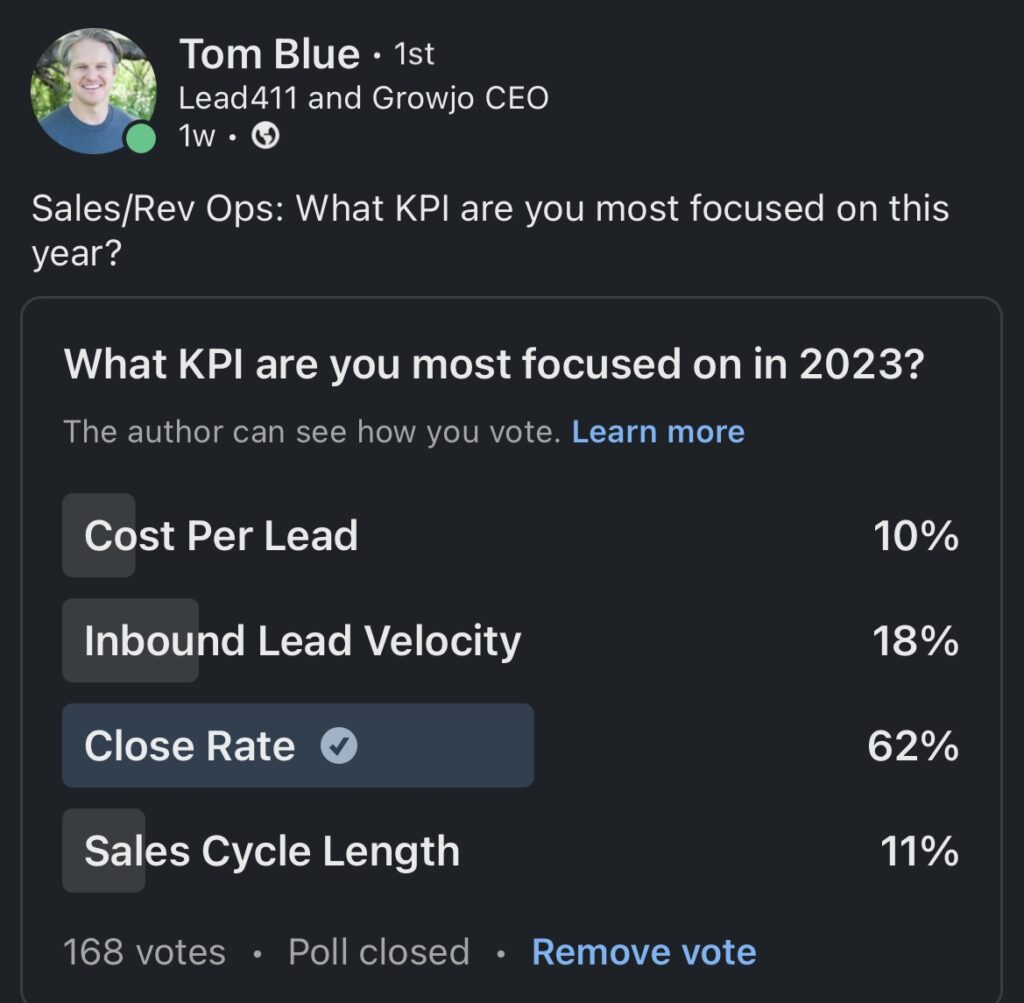Conversion is a North Star metric for most revenue teams in B2B sales. A typical B2B sales process requires prospects to move through the funnel. Before a prospect advances to the next funnel stage, certain criteria must be met.
Every action a seller takes moves them closer or further away from a prospect that converts to a won deal.
For example:
- A Prospect converts to a Lead
- A Lead converts to a Qualified Lead
- A Qualified Lead converts to an opportunity, and
- An Opportunity converts to a Closed-won deal.
Thinking of a standard sales funnel, a closed-won deal is a series of conversions over time.
A recent LinkedIn Poll asked revenue leaders what their focus was for their teams in 2023:
- Cost per Lead
- Inbound Lead Velocity
- Close Rate (Conversion)
- Sales Cycle Length
62% of respondents answered with conversion.

For revenue teams, effective use of best-practice tactics will increase conversion rate. Higher conversion rates are the reward for a series of wins along the buyer’s journey. And in B2B sales, research is a critical foundation from which a sales process can launch.
Research with Bias to drive higher Conversion Rates in B2B Sales
“A research mindset focuses on learning in pursuit of answering relevant questions.” Erica Salinas
You have likely heard the phrase “starting off on the right foot”. For outbound sellers (and most revenue team members), research is a critical first step. Sellers have to know their accounts. Prospects are harder to engage, and fewer leads flow through the funnel with poor research.
Erica Salinas, Principal Tech Leader @ Amazon gives a great description of a research mindset. She says “A research mindset focuses on learning in pursuit of answering relevant questions. It helps us confirm key assumptions.”
In B2B sales, researching with a bias is necessary. But research efficiency is a product of good industry insight. As sellers gain experience in their industry, they will begin to build insight. Insight develops over time, but it can also be shared by experienced team members.
With this insight, effective research can begin.
For example, a seller knows that most Craft Alcohol producers are not logistics-savvy.
Without a plan, a new seller may research the company’s digital footprint inefficiently. They could spend 20 minutes or more searching for everything they can find about the company. They are researching to get familiar, not confirm a bias.
An experienced seller will search the company’s digital footprint with purpose. They search social media and the company website to confirm their bias. In this example, the seller needs to know if the company has a delivery fleet. Often a photo of the branded delivery trucks would be on Facebook or their Corporate site. Sometimes a job description for an open delivery driver position exists. Once found, this research point is complete and the seller can move on. No need to spend more time searching for information that isn’t truly critical.
Revenue leaders need to establish a research checklist for their teams. When a team has research process alignment, sellers will be more consistent. An account would rarely need a research deep-dive. Begin the sales process as soon as the research checklist is complete.
There are two important spin-off benefits to research alignment as well.
-
Revenue leaders who align their sellers on research best-practice also drive efficiency. Use this alignment to share shortcuts and tips among the team.
-
Top-of-funnel leads and pipeline criteria become consistent from one seller to another. Two top-of-funnel leads should share many similar criteria if researched properly.
Time to First Call – The Research Metric
There needs to be a metric to measure if research with a bias is helping your sellers. But how do you measure research efficiency? Look at how long it takes a rep to make their first call. Give your sellers a new target account at 9 am. Observe how long they research the prospect before they can confidently make their first call.
Armed with the appropriate amount of critical research, a seller should be able to make their first call to a prospect in 7-15 minutes. This call should show the prospect that the seller has an understanding of their business and typical challenges. A prospect who feels understood is more likely to trust and find the seller credible.
The Result of Effective Prospect Research for B2B Sales
A sales rep with an effective research plan will be able to make a confident first call, faster. Their research should produce/inform:
- Tailored Value Proposition
- Relevant 1st question
- Insight into possible business challenges
When a sales rep has these “boxes” checked, a confident first call can be made. And if they have a purpose and process behind their research method, it can be done faster.
Here at AGS, we generate qualified sales leads for our clients that convert. Our clients experience a 70% conversion rate for MQLs to SQLs and SQLs to Opportunities. The industry average is between 20-40%.
There isn’t one single tactic we use to drive high-converting B2B qualified sales leads. Our conversion rate is a combination of many small, critical actions. We deploy these daily to drive our clients’ revenue goals forward.
We are going to share more detail on these actions we take through our blog and podcast. If you would like to subscribe and have them delivered right to your device, drop your information below.
Get our Conversion Tactics delivered.
We will email our best conversion-focused content to ou as soon as it’s available. No spam, we promise.

